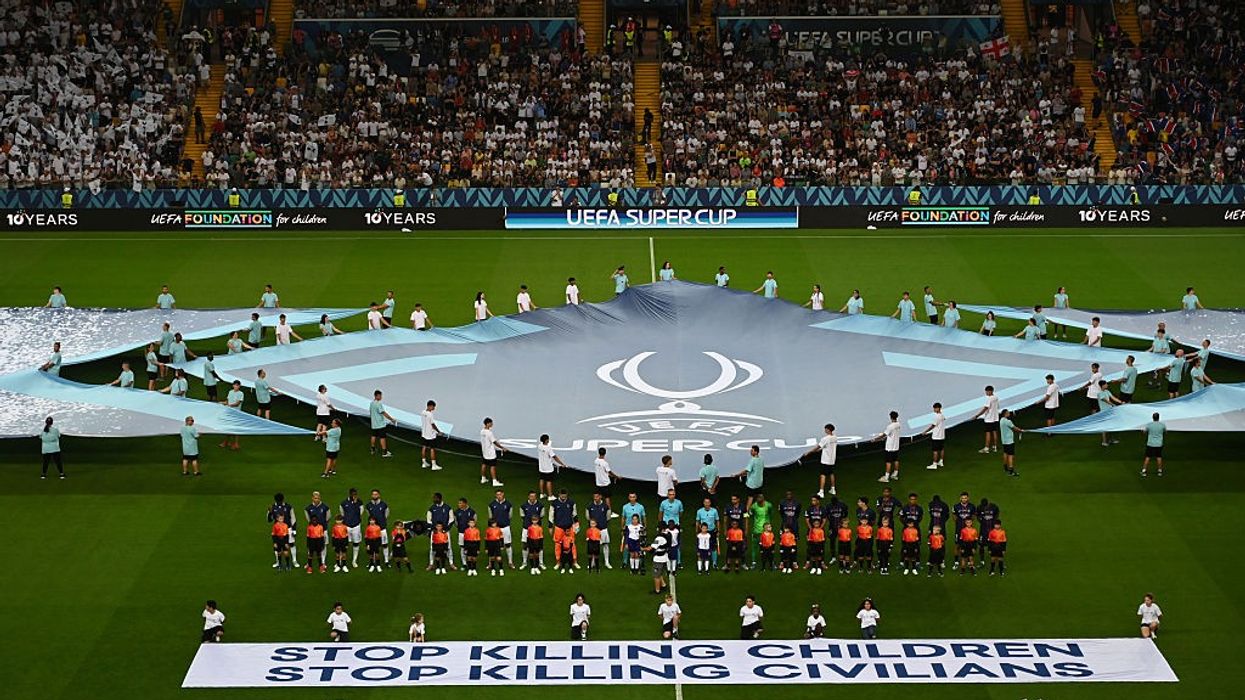Italian Coaches Call for 'Genocidal' Israel's Suspension From FIFA, UEFA
"People might want us to just shut up and play, turn to look the other way, but we don't believe that is right."
The Italian Association of Football Coaches on Tuesday formally called on soccer's international and European governing bodies to suspend Israel over its "genocidal" annihilation of Gaza, a move that came ahead of next month's FIFA World Cup qualifying matches between the Azzurri and the Skyblue-and-Whites.
"Can a football match, preceded by the national anthems, be considered only a football match? Can what is happening in the Gaza Strip, with heavy reverberations in the West Bank and Lebanon, simply be counted as one of the 56 active conflicts in the world?" the AIAC National Board of Directors wrote in a letter.
"Can the Hamas terrorist massacre on October 7, 2023, with over a thousand innocent Israeli victims plus the taking of 250 hostages, justify Israel's ferocious genocidal retaliation, which has claimed tens of thousands of Palestinian civilian deaths?" the letter asks.
"These are all questions that the Italian Association of Football Coaches has asked itself and that it now asks the other federation components and the [Italian Football Federation] in light of the upcoming matches that will see the Italian national team, on September 8 and October 14, play the Israeli one," the coaches said.
The letter was commended by Francesca Albanese, the United Nations special rapporteur on the occupied Palestinian territories, who is Italian.The AIAC directors said they "unanimously believe that, faced with daily massacres, which have caused hundreds of deaths" of Gazan athletes and coaches, "including the Palestinian football star Suleiman al-Obeid," that "it is legitimate, necessary, and indeed dutiful" to ask the International Federation of Association Football (FIFA) and the Union of European Football Associations (UEFA) to temporarily suspend Israel, "because the pain of the past cannot obscure any consciousness and humanity."
AIAC president Renzo Ulivieri said in a statement that "this must not be just a symbolic gesture, but a necessary choice, which responds to a moral imperative, shared by the entire directorial board."
Giancarlo Camolese, AIAC's vice president, told the Italian news agency ANSA, "People might want us to just shut up and play, turn to look the other way, but we don't believe that is right."
Last week, UEFA president Aleksander Čeferin said that it is "legitimate" to question why the organization banned Russia over its invasion and occupation of Ukraine but not Israel for its genocidal annihilation of Gaza. This, after UEFA invited refugee children including Gazans to unfurl a banner reading "STOP KILLING CHILDREN" and "STOP KILLING CIVILIANS" on the pitch before a Super Cup match between Paris Saint-Germain and Tottenham Hotspur in Udine, Italy.
UEFA was criticized for not specifying who is killing children and civilians, just as it faced backlash for a tribute omitting who killed al-Obeid—known as the "Pelé of Palestinian football"—after he was slain by Israeli forces while trying to obtain food aid amid a growing forced famine in Gaza.
Israeli forces have killed hundreds of footballers in Gaza, where more than 62,000 Palestinians—mostly women and children, with the actual toll likely far higher—have been slain since October 2023 in a war for which Israel is facing a genocide case currently before the International Court of Justice (ICJ) and for which Israeli Prime Minister Benjamin Netanyahu is wanted by the International Criminal Court (ICC) for alleged crimes against humanity.
Israeli forces have also used sporting sites including Yarmouk Stadium for the detention of Palestinian men, women, and children, many of whom have reported torture and other abuse at the hands of their captors.
As they did before last year's Olympic Games in Paris, critics of Israel's obliteration of Gaza have called for the country's suspension from not only UEFA matches but also from next year's FIFA World Cup in Canada, Mexico, and the United States.
Unlike a growing number of countries in Europe and around the world, Italy has not signaled that it will recognize Palestinian statehood or support international efforts to hold Israel accountable for its crimes, most notably by supporting the ICJ genocide case. Italian Prime Minister Giorgia Meloni's government has also joined her counterparts in France and Germany in granting Netanyahu immunity from enforcement of the ICC arrest warrant.


